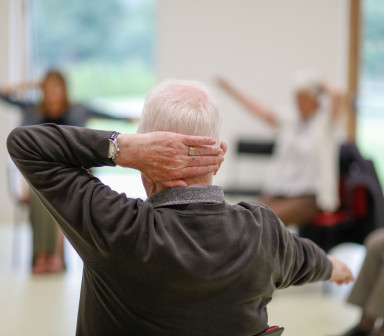Swimming is a sport that most people have enjoyed at some point in their lives – and it can be an excellent sport for people who have a visual impairment.
Hawkhead Centre Officer, Abbie, who also has over ten years’ experience as a swimming instructor, has been supporting many veterans with sight loss to experience swimming again.
Here are some of Abbie’s top tips for swimming after sight loss.
Why is swimming great for people with a visual impairment?
Swimming is a great form of exercise for anyone of any age. For people who have a visual impairment, the pool can be a great place to exercise as you can choose and stick with a depth you are comfortable with. Even a simple walk up and down the shallow end is a workout due to the water resistance.
Swimming pools have useful features to help you keep your bearings, like coloured lane ropes. Most pools will have a lane or two marked out that requires swimmers to swim in a clockwise or anti-clockwise direction – this means that you won’t have to look out for anyone swimming towards you.
In addition, counting arm strokes is a good way to indicate how far you have left until you reach the wall of the pool.
For people with mobility issues, including those who use a wheelchair, the water is great as supports your weight and joints, reducing pressure on the knees and hips etc., and really helps you to keep your balance.
Not only is swimming great for physical health, being in the water provides a relaxing atmosphere where you can unwind, relieve any tension and relax the mind.
Top tips for swimming after losing you sight
- Take someone with you who can guide, support, and help you to get an awareness of the surroundings. Try picking a quieter time to go to the pool if possible while you build confidence.
- We also recommend letting the lifeguard know you have a visual impairment before you enter the pool so they can provide any assistance required and ensure you are safe. Anyone with mobility issues can be assisted to the poolside by lifeguards if needed.
- Take it easy to start building confidence. Perhaps begin with walking up and down in the water at your own speed until you are more comfortable. Stay close to the shallower end where you can stand if you need to stop for any reason. If you want to try lane swimming, we recommend getting to know the swimming direction rules before entering a lane.
- Remember to listen out for any instruction or whistle calls from lifeguards, as this is how they can guide and reassure you if needed, as well as ensure your safety.
- You can also ask for floatation devices such as noodles, or swim belts. As well as supporting you in the water, using a float shows other swimmers that you are building your confidence, which in turn can give you more space.
- The more you visit the pool and keep swimming, the more you’ll build up confidence.
At Sight Scotland Veterans we’ll support any one of our veterans with sight loss to give swimming a try ,wherever possible, if it’s something they are interested in. Some have not been in a swimming pool for years, or have never learned to swim before.
You may surprise yourself about how quickly it comes to you again, or how quickly you can pick it up if you’re starting to learn. You will also leave feeling refreshed and energetic. Swimming really is for anyone.
